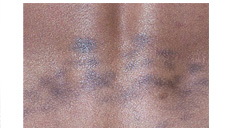







Hyperpigmentation caused by erythema dyschromicum perstans
This disorder was first described in Central America in 1957 in the Hispanic literature as “Los Cenicientos,” which means “the ashen ones” in Spanish. Although the disease has been reported worldwide, it is most commonly seen and reported in young patients from Central America. Erythema dyschromicum perstans is also prevalent in blacks and Asians (particularly South Asians).
It clinically manifests as asymptomatic ashy, blue-black hyperpigmented macules and patches on the face, back, arms, and legs. The palms and soles are typically spared. As the pigment is dermal in origin, there is no accentuation with Wood’s lamp. There is usually no associated systemic disease.
Histologically, there is an increase in dermal melanophages with an overlying increase in epidermal melanin. There is epidermal spongiosis and basal layer vacuolization with dermal perivascular infiltrate in early lesions. Active lesions reveal colloid bodies that have dropped into the dermis. This resolves with time, leaving dermal hyperpigmentation. As in dermal melasma, there is a blue appearance clinically secondary to the Tyndall effect.
The disease has no known cause. Some investigators believe that given the histological similarities to lichen planus, it is possibly a variant. It is not responsive to topical corticosteroids, however, unlike lichen planus.
Treatments have included systemic therapy with clofazamine, with mild to moderate success, respectively. Given the dermal location of the pigment, lasers such as the 694-nm Q-switched ruby may be beneficial in treating the disorder. Further studies are necessary for determination of therapeutic efficacy.
>
>
>
>
>
>
>
>
>
>
>
>
>
>
>
>
>
>
>
>
>
>
>
>
>
>
INTRODUCTION
PIGMENTARY DISORDER TYPES
Disorders of
Hyperpigmentation
Disorders of Hypopigmentation
COMMON PIGMENTARY DISORDERS
Age Spots/Liver Spots/Lentigos
Acanthosis Nigricans
Albinism
Cafe-au-Lait Macules
Ephelides (Freckles)
Erythema Dyschromicum Perstans (Ashy Dermatosis)
Familial Racial Periorbital Hyperpigmentation
Idiopathic Guttate Hypomelanosis
Leopard Syndrome
Linea Nigra
Melanoma
Melasma
Nevus (birthmarks/moles)
Parkinsons Disease
Phytophotodermatits
Pityriasis Alba
Poikiloderma of Civatte
Postinflammatory
Hyperpigmentation & Hypopigmantation
Seborrheic Keratoses
Sturge-Weber Syndrome
Substance Induced
Hypermelanosis
Tinea Nigra/Tinea Versicolor/Pityriasis
Versicolor
Vitiligo
Waardenburg Syndrome

<< Previous: Ephelides/Freckles
Next: Familial Racial Periorbital Hyperpigmentation >>